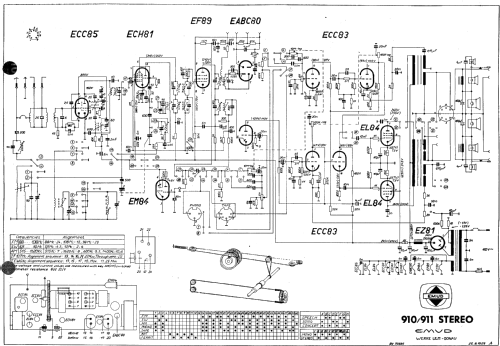910 Stereo
Emud, Ernst Mästling; Ulm
- Hersteller / Marke
- Emud, Ernst Mästling; Ulm
- Jahr
- 1959 ?
- Kategorie
- Rundfunkempfänger (Radio - oder Tuner nach WW2)
- Radiomuseum.org ID
- 116943
Klicken Sie auf den Schaltplanausschnitt, um diesen kostenlos als Dokument anzufordern.
- Anzahl Röhren
- 10
- Hauptprinzip
- Superhet allgemein; ZF/IF 460/10700 kHz
- Wellenbereiche
- Mittelwelle, Kurzwelle und UKW (FM).
- Betriebsart / Volt
- Wechselstromspeisung / 110 Volt
- Lautsprecher
- 6 Lautsprecher
- von Radiomuseum.org
- Modell: 910 Stereo - Emud, Ernst Mästling; Ulm
- Bemerkung
- Mono Radio mit Gegentakt-Endstufe, umschaltbar auf Stereo-NF-Verstärker mit jeweils einer EL84 pro Kanal.
- Literatur/Schema (1)
- -- Original-techn. papers.
- Autor
- Modellseite von Pius Steiner angelegt. Siehe bei "Änderungsvorschlag" für weitere Mitarbeit.
- Weitere Modelle
-
Hier finden Sie 422 Modelle, davon 328 mit Bildern und 231 mit Schaltbildern.
Alle gelisteten Radios usw. von Emud, Ernst Mästling; Ulm
Forumsbeiträge zum Modell: Emud, Ernst Mästling: 910 Stereo
Threads: 2 | Posts: 7
Gregg Ruecker, 24.Jan.15
Greetings,
I am a new member with Radiomuseum and I live in the United States. I am a Ham operator and tube hobbyist. I have restored many amps and tuners form the US. I have just recently started to work on a beautiful Emud console stereo, model #910. I have the schematic and I have this question. The way the schematic is shown is a bit different from what I am used to here in the US. Can anyone help me understand the Europeon schematics. My main question is how the switches are displayed and identified. On the schematic that I have, it shows the switches with numbered circles and there is a table with dots that somehow correspond to the different switches. The switches are not actually named on the schematic. Can anyone help me understand how to put these two pieces of information together to identify the swiches in the schematic? Also, in the US we often have two seperate output transformers for a stereo amplifier. It appears that this chassis has only one OT. Am I to assume two seperate windings in this transformer? It also appears that the negative feedback is taken from a seperate tap on the transformer....is this also common? Anyway, I find the unit to be very nicely built and am looking forward to getting it operational...it's just a little different from what I am used to so any help would be greatly appreciated. Please excuse my dumb questions.
Thanks,
Gregg Ruecker
edited the title
Gregg Ruecker, 04.Mar.10
